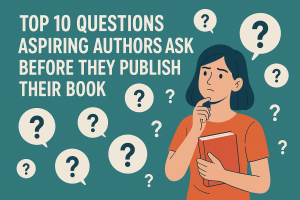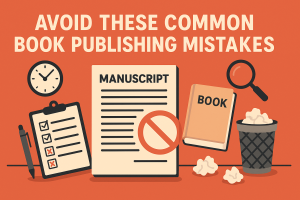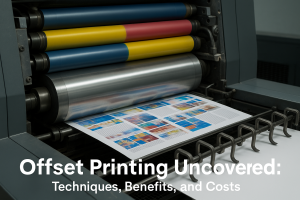The world of book publishing has evolved dramatically over the past few decades, transforming from a traditional industry dominated by major publishing houses to a diverse ecosystem that offers multiple pathways for authors to bring their work to readers. Whether you’re a first-time author with a manuscript burning in your desk drawer or an experienced writer looking to explore new distribution channels, understanding the intricacies of publishing, sharing, and distribution is crucial for your success in today’s competitive literary marketplace.
This comprehensive guide will walk you through every aspect of the publishing journey, from the initial decision of how to publish your work to the final steps of getting your book into the hands of eager readers. We’ll explore the various publishing models available, examine the role of professional book publishing services, delve into the technical aspects of book production, and provide you with actionable strategies for effective distribution and marketing.
Understanding the Modern Publishing Landscape
The contemporary publishing industry presents authors with an unprecedented array of options and opportunities. Gone are the days when aspiring writers had to rely solely on the approval of traditional publishers to see their work in print. Today’s publishing landscape is characterized by flexibility, accessibility, and the democratization of the publishing process, allowing authors to maintain greater control over their creative work while reaching global audiences.
Traditional publishing still maintains its position as the most prestigious path, involving established publishing houses that handle everything from editing and design to marketing and distribution. However, this route often requires authors to navigate a complex system of literary agents, submission processes, and lengthy wait times, with no guarantee of acceptance. The traditional model also means authors typically receive smaller royalty percentages while giving up significant control over their work’s presentation and marketing approach.
Self-publishing has emerged as a powerful alternative, empowering authors to maintain complete creative and financial control over their projects. This approach allows writers to make all decisions regarding their book’s content, design, pricing, and marketing strategy. While self-publishing requires authors to take on responsibilities traditionally handled by publishers, it also offers the potential for higher royalty rates and faster time-to-market.
Hybrid publishing represents a middle ground between traditional and self-publishing models, combining elements of both approaches. Authors working with hybrid publishers typically invest in professional book publishing services while retaining more control and receiving higher royalties than traditional publishing would offer. This model has gained popularity among authors who want professional support without sacrificing their creative autonomy.
The rise of digital publishing has further expanded the landscape, with e-books and audiobooks becoming increasingly popular among readers. Digital formats offer unique advantages including lower production costs, instant global distribution, and the ability to update content easily. However, print books continue to hold significant market share, with many readers preferring the tactile experience of physical books.
Choosing Your Publishing Path
Selecting the right publishing path is one of the most critical decisions you’ll make as an author, and this choice will significantly impact every subsequent aspect of your publishing journey. The decision requires careful consideration of your goals, resources, timeline, and long-term career objectives, as each publishing model offers distinct advantages and challenges that align differently with various author priorities.
Traditional publishing offers the prestige and validation that comes with being selected by an established publisher, along with professional editing, design, marketing, and distribution services. Publishers handle the financial investment and risk, meaning authors don’t need to pay upfront costs. The traditional route also provides access to bookstore distribution networks, media coverage opportunities, and industry connections that can be valuable for career development. However, the process is highly competitive, often requiring months or years to secure a publishing contract, and authors typically receive only 10-15% royalties while giving up significant control over their work.
Self-publishing provides maximum creative control and potentially higher profits, with authors keeping 35-70% royalties depending on the platform and distribution channels chosen. This path allows for rapid publication timelines, complete control over pricing and marketing strategies, and the ability to build a direct relationship with readers. Authors can experiment with different genres, formats, and marketing approaches without requiring publisher approval. The challenges include taking full responsibility for all aspects of production, marketing, and distribution, which requires significant time investment and learning new skills outside of writing.
Hybrid publishing bridges the gap between traditional and self-publishing by offering professional services while allowing authors to retain more control and higher royalties than traditional publishing typically provides. Authors invest in professional book publishing services but benefit from expert guidance in editing, design, and marketing while maintaining ownership of their work. This model works well for authors who have the budget to invest in professional services but want more control than traditional publishing allows.
When evaluating your options, consider your budget, timeline, career goals, and willingness to take on business responsibilities. Authors with limited budgets and tight timelines might lean toward self-publishing, while those seeking industry validation and willing to wait for potential acceptance might pursue traditional routes. Writers with moderate budgets who want professional support while maintaining control often find hybrid publishing appealing.
Working with Professional Book Publishing Services
Professional book publishing services have become increasingly sophisticated and accessible, offering authors comprehensive support throughout the publishing process while allowing them to maintain control over their work. These services range from basic formatting and cover design to complete publishing packages that include editing, marketing, and distribution support, making professional-quality publishing achievable for authors at various budget levels and experience stages.
Editorial services form the foundation of professional publishing support, encompassing developmental editing, copy editing, and proofreading. Developmental editing focuses on big-picture elements like plot structure, character development, pacing, and overall narrative coherence, helping authors strengthen their manuscript’s fundamental elements before moving to production. Copy editing addresses grammar, syntax, style consistency, and factual accuracy, ensuring the text reads smoothly and professionally. Proofreading provides the final quality check, catching any remaining errors before publication.
Design services include both cover design and interior layout, both crucial for creating a professional-looking book that appeals to readers and meets industry standards. Cover design involves creating compelling artwork that accurately represents the book’s content while appealing to the target audience and standing out in crowded marketplaces. Interior design encompasses typography selection, page layout, chapter formatting, and ensuring proper spacing and alignment throughout the book, creating a reading experience that feels polished and professional.
Marketing and promotional services help authors develop comprehensive strategies for reaching their target audience and building readership. These services might include creating marketing materials, developing social media strategies, organizing book launch events, securing book reviews, and implementing advertising campaigns across various platforms. Professional marketing support can be particularly valuable for authors who lack experience in promotion or prefer to focus their time on writing rather than marketing activities.
Distribution services ensure books reach readers through multiple channels, including online retailers, physical bookstores, libraries, and specialty outlets. Professional services often have established relationships with distributors and can help authors navigate the complex requirements of different sales channels while ensuring books are properly formatted and listed across various platforms.
When selecting professional book publishing services, research providers thoroughly by examining their portfolios, reading client testimonials, and understanding their pricing structures and timelines. Look for services that align with your specific needs and budget while maintaining high quality standards that will enhance your book’s professional appearance and market appeal.
The Technical Side of Book Production
Understanding the technical aspects of book production is essential for making informed decisions about your publishing project and ensuring your final product meets professional standards and reader expectations. The production process involves numerous technical considerations that directly impact both the quality of your finished book and the overall cost of your publishing project, making it crucial to understand these elements before moving forward with production.
Manuscript formatting represents the first technical step in book production, involving the transformation of your raw manuscript into a properly structured document ready for design and layout. Proper formatting includes consistent paragraph spacing, appropriate heading hierarchies, proper chapter breaks, and clean text free from unusual formatting artifacts that might interfere with the design process. Many authors benefit from professional formatting services to ensure their manuscript meets industry standards and provides a solid foundation for the design phase.
Interior design encompasses the visual presentation of your book’s content, including typography selection, page layout, margin specifications, and overall visual hierarchy. Typography choices significantly impact readability and the overall aesthetic appeal of your book, with different font families and sizes creating different reading experiences and conveying different tones. Page layout involves determining appropriate margins, line spacing, and paragraph formatting to create pages that are both visually appealing and comfortable to read.
Cover design requires balancing artistic appeal with marketing effectiveness, creating a cover that accurately represents your book’s content while standing out in competitive marketplaces. Technical considerations include ensuring proper resolution for both print and digital formats, understanding spine width calculations for print books, and creating designs that remain legible and appealing at thumbnail sizes used in online retailers.
File preparation for different distribution channels requires understanding the specific technical requirements of various platforms and formats. Print books require high-resolution PDF files with proper color profiles, bleed areas, and spine calculations, while e-books need properly formatted EPUB or MOBI files with optimized images and interactive elements. Each distribution platform has specific requirements for file formats, dimensions, and technical specifications that must be met for successful publication.
Quality control processes ensure your finished product meets professional standards before reaching readers. This includes thorough proofreading of formatted text, checking that images and graphics display correctly, verifying that interactive elements in digital formats function properly, and ensuring that print proofs match expectations for color, spacing, and overall appearance.
Printing Options and Considerations
The printing phase of book production involves numerous decisions that significantly impact both the cost and quality of your finished product, making it essential to understand the various printing options available and their respective advantages and limitations. Modern printing technology offers authors flexibility in terms of quantity, quality, and cost, allowing for printing strategies that align with different publishing goals and budget constraints.
Print-on-demand technology has revolutionized book printing by eliminating the need for large upfront print runs and storage costs. This approach allows books to be printed individually as orders are received, making it possible for authors to offer print books without significant financial investment or inventory management challenges. Print-on-demand services typically integrate with major online retailers, automatically fulfilling orders as they’re placed and handling shipping directly to customers. While the per-unit cost is higher than traditional offset printing, the elimination of upfront costs and storage requirements makes this option attractive for many authors, particularly those just starting their publishing journey.
Offset printing remains the preferred choice for large print runs, typically becoming cost-effective for orders of 1,000 copies or more. This traditional printing method offers superior print quality, more paper and binding options, and significantly lower per-unit costs for large quantities. Offset printing allows for special finishes, custom paper stocks, and premium binding options that may not be available through print-on-demand services. However, offset printing requires substantial upfront investment and creates inventory management challenges, making it most suitable for authors with established audiences or significant marketing budgets.
Digital printing serves as a middle ground between print-on-demand and offset printing, offering good quality and reasonable pricing for medium-sized print runs typically ranging from 25 to 500 copies. Digital printing provides faster turnaround times than offset printing while offering better quality and more customization options than basic print-on-demand services. This option works well for authors who want to order books for local events, direct sales, or testing market response before committing to larger print runs.
When working with book printing companies, consider factors beyond just price, including print quality, paper options, binding choices, customer service, and delivery times. Request samples of similar books to evaluate print quality, and ensure the printer can meet your timeline requirements while maintaining quality standards. Understanding the technical specifications required by your chosen printer, including file formats, color profiles, and bleed requirements, will help ensure smooth production and avoid costly delays or reprints.
Distribution Strategies and Channels
Effective distribution strategy is crucial for connecting your book with readers and maximizing your sales potential across multiple channels and markets. Modern distribution encompasses both traditional retail channels and emerging digital platforms, requiring authors to develop comprehensive approaches that leverage multiple touchpoints while considering the unique requirements and opportunities each channel presents.
Online retail platforms dominate modern book sales, with Amazon leading the market but numerous other platforms offering valuable opportunities for reaching different audiences. Each platform has unique requirements, pricing structures, and promotional opportunities that authors should understand and leverage. Amazon’s Kindle Direct Publishing offers both print and digital distribution with competitive royalty rates and powerful promotional tools, while platforms like IngramSpark provide broader distribution to bookstores and libraries. Apple Books, Google Play Books, and other digital platforms each serve specific reader demographics and geographic markets.
Traditional retail distribution through bookstores and libraries requires different approaches and often involves working with distributors who have established relationships with physical retail locations. Independent bookstores often support local authors and may be willing to host events or feature books prominently, while chain bookstores typically work through corporate buyers and distributors. Library distribution can provide steady sales and help build author credibility, particularly for non-fiction titles that align with library collection development goals.
Direct sales opportunities allow authors to maintain higher profit margins while building direct relationships with readers. This approach might include selling books at author events, through personal websites, at speaking engagements, or through social media platforms. Direct sales require more active involvement from authors but can be particularly effective for building fan loyalty and generating word-of-mouth marketing.
International distribution opens up global markets but requires understanding different regional requirements, tax implications, and cultural preferences. Many distribution platforms offer international reach, but authors should research specific markets to understand pricing strategies, marketing approaches, and cultural considerations that might impact their book’s reception in different regions.
Specialty distribution channels serve specific markets or demographics that might align with your book’s target audience. This could include educational distributors for academic or instructional content, specialty retailers for niche topics, or subscription services that curate books for specific reader interests. Identifying and pursuing relevant specialty channels can help you reach highly engaged readers who are specifically interested in your book’s topic or genre.
Digital Distribution and E-book Platforms
The digital publishing ecosystem has created unprecedented opportunities for authors to reach global audiences instantly while maintaining higher profit margins than traditional publishing typically offers. Understanding the various digital platforms, their unique features, and optimization strategies is essential for maximizing your book’s digital presence and sales potential in an increasingly competitive online marketplace.
Major e-book platforms each offer distinct advantages and serve different reader demographics, making it important to develop platform-specific strategies rather than taking a one-size-fits-all approach. Amazon’s Kindle platform dominates the e-book market and offers powerful promotional tools including Kindle Unlimited, Kindle Select exclusivity benefits, and sophisticated advertising options. However, Amazon’s exclusivity requirements for some promotional programs limit distribution to other platforms, requiring authors to weigh the benefits of exclusivity against broader distribution reach.
Apple Books serves the iOS ecosystem and offers unique features like enhanced e-books with multimedia elements, appealing to readers who prefer Apple devices and appreciate premium presentation. Google Play Books provides access to Android users and international markets, while platforms like Kobo have strong presences in specific geographic regions and offer different promotional opportunities. Each platform has specific formatting requirements, pricing strategies, and promotional tools that authors should understand and leverage.
E-book optimization involves more than simply converting your manuscript to digital format. Effective e-books require careful attention to formatting that ensures readability across various devices and screen sizes. This includes proper heading hierarchy for navigation, optimized images that display well on different screens, interactive table of contents, and metadata that helps readers discover your book through search functions. Understanding how different devices and reading apps display your content ensures a positive reading experience regardless of how readers access your book.
Pricing strategies for digital books differ significantly from print pricing, and effective digital pricing requires understanding market dynamics, reader expectations, and platform-specific factors. Digital books typically sell for less than print versions, but authors often receive higher royalty percentages that can result in greater profits per sale. Dynamic pricing strategies, including launch promotions, seasonal sales, and platform-specific pricing, can help maximize both sales volume and revenue over time.
Marketing digital books requires different approaches than marketing print books, with emphasis on online discoverability, social media promotion, and leveraging platform-specific promotional tools. This includes optimizing book descriptions for search algorithms, selecting appropriate categories and keywords, building relationships with book bloggers and reviewers who focus on digital content, and utilizing social media platforms where your target readers spend time.
Marketing and Promotion Fundamentals
Successful book marketing requires a comprehensive approach that begins long before publication and continues well after your book becomes available to readers. Effective promotion involves understanding your target audience, developing compelling messaging that resonates with potential readers, and implementing multi-channel strategies that build awareness and drive sales over time. The key to successful book marketing lies in consistency, authenticity, and providing value to your audience beyond just promoting your book.
Audience identification forms the foundation of all effective marketing efforts, requiring deep understanding of who your ideal readers are, what they value, where they spend time, and how they make purchasing decisions. This involves researching demographic information, reading preferences, online behavior, and the types of content that engage your target audience. Understanding your audience allows you to craft marketing messages that speak directly to their interests and needs while choosing the most effective channels for reaching them.
Brand building for authors involves developing a consistent and authentic presence that reflects your personality, expertise, and the value you provide to readers. Your author brand should be evident across all marketing channels, from your website and social media profiles to your book covers and promotional materials. Consistency in messaging, visual elements, and tone helps readers recognize and remember you, building trust and loyalty over time.
Content marketing provides valuable information or entertainment to your audience while subtly promoting your expertise and books. This might include blog posts, articles, videos, podcasts, or social media content that addresses topics related to your book’s subject matter or themes. Effective content marketing positions you as an authority in your field while providing genuine value to your audience, naturally leading to interest in your books.
Social media marketing allows for direct engagement with readers and provides platforms for sharing content, building community, and promoting your work. Different social media platforms serve different purposes and audiences, requiring tailored approaches for each. Building authentic relationships with readers through social media creates loyal fans who are more likely to purchase your books and recommend them to others.
Email marketing remains one of the most effective tools for author promotion, providing direct communication with interested readers and allowing for personalized messaging and targeted campaigns. Building an email list of engaged subscribers creates a valuable asset that you control, unlike social media followers who are subject to platform algorithm changes. Regular newsletters, exclusive content, and special offers help maintain reader engagement between book releases.
Building Your Author Platform
Developing a strong author platform is essential for long-term publishing success, providing the foundation for connecting with readers, building credibility, and marketing your books effectively. An author platform encompasses all the ways you connect with and provide value to your audience, including your online presence, speaking engagements, media appearances, and direct reader interactions. Building a platform takes time and consistent effort, but it becomes an invaluable asset that supports all your publishing endeavors.
Your author website serves as the central hub of your online presence, providing a professional space where readers can learn about you and your work, access your content, and connect with you directly. An effective author website should include compelling author bio, information about your books, blog or content section, contact information, and ways for visitors to stay connected through email signup or social media links. The website should reflect your author brand and provide clear value to visitors while being easy to navigate and mobile-friendly.
Social media presence allows for regular interaction with readers and provides platforms for sharing content, promoting your work, and building community around your writing. Different platforms serve different purposes, and effective authors typically focus on one or two platforms where their target audience is most active rather than trying to maintain presence on every platform. Consistency in posting, authentic engagement with followers, and sharing valuable content beyond just book promotion helps build genuine relationships with readers.
Content creation demonstrates your expertise and provides ongoing value to your audience while subtly promoting your books and building your reputation as an authority in your field. This might include blog posts, articles, videos, podcasts, or other content that addresses topics related to your writing or areas of expertise. Regular content creation keeps you visible to your audience between book releases and provides material for sharing across various marketing channels.
Speaking engagements and media appearances provide opportunities to reach new audiences, demonstrate your expertise, and build credibility as an author. This might include conference presentations, podcast interviews, workshop facilitation, or local speaking events. Developing compelling presentation topics and becoming comfortable with public speaking opens doors to numerous promotional opportunities while positioning you as an expert in your field.
Networking within the writing and publishing community creates valuable relationships that can lead to collaboration opportunities, promotional support, and industry insights. Building relationships with other authors, bloggers, reviewers, and industry professionals expands your reach and provides mutual support for promotional activities. Genuine relationship building, rather than purely transactional interactions, creates lasting connections that benefit all parties involved.
Measuring Success and Planning for Growth
Understanding how to measure your publishing success and plan for future growth is crucial for building a sustainable author career and making informed decisions about your publishing strategy. Success metrics vary depending on your goals, publishing model, and career stage, requiring you to identify the most relevant indicators for your specific situation while maintaining realistic expectations and long-term perspective.
Sales metrics provide direct feedback on your book’s market performance, but understanding these numbers requires context and perspective. Unit sales, revenue, and royalty earnings are obvious success indicators, but comparing your results to appropriate benchmarks and understanding seasonal patterns, marketing impact, and long-term trends provides more meaningful insights. Many successful authors see steady growth over time rather than immediate bestseller status, making consistency and persistence more important than dramatic initial sales spikes.
Reader engagement metrics help you understand how your audience responds to your work and marketing efforts. This includes social media engagement rates, email open rates, website traffic, review quantity and quality, and direct reader feedback. High engagement often correlates with stronger sales over time and indicates building a loyal readership that will support future book releases.
Platform growth metrics track your increasing ability to reach and influence your target audience. This includes email subscriber growth, social media follower increases, website traffic trends, and speaking opportunity frequency. A growing platform typically leads to improved book sales and opens doors to additional opportunities like speaking engagements, media appearances, and partnership opportunities.
Market positioning analysis helps you understand how your books perform relative to competitors and identify opportunities for improvement or differentiation. This involves tracking your books’ rankings in relevant categories, analyzing competitor pricing and promotional strategies, and staying current with market trends that might impact your publishing decisions.
Planning for growth involves setting realistic goals, developing strategies for achieving them, and creating systems that support scaling your publishing efforts. This might include planning multiple book releases, developing series or related content, expanding into new formats or markets, or building team support for tasks like marketing, editing, or administrative work. Successful authors typically develop long-term publishing plans that build on previous successes while exploring new opportunities for reaching readers and growing their careers.
Regular evaluation and adjustment of your publishing strategy ensures you’re making progress toward your goals while adapting to changing market conditions and personal circumstances. This involves regularly reviewing your metrics, assessing what’s working and what isn’t, and making informed adjustments to your approach based on data and experience rather than assumptions or emotions.
Conclusion and Next Steps
Successfully navigating the complex world of book publishing, sharing, and distribution requires careful planning, strategic thinking, and consistent execution across multiple areas of focus. From choosing the right publishing path and working with professional book publishing services to implementing effective marketing strategies and building a sustainable author platform, each element plays a crucial role in your overall publishing success.
The modern publishing landscape offers unprecedented opportunities for authors to reach readers while maintaining control over their creative work and financial future. Whether you choose traditional publishing, self-publishing, or hybrid approaches, success ultimately depends on understanding your options, making informed decisions, and consistently delivering value to your readers through quality content and professional presentation.
Remember that building a successful publishing career is typically a long-term endeavor that requires patience, persistence, and continuous learning. The most successful authors view each book as part of a larger career strategy, using lessons learned from each project to improve their craft, refine their marketing approaches, and strengthen their connections with readers.
As you embark on or continue your publishing journey, focus on creating quality content that serves your readers, building authentic relationships with your audience, and maintaining professional standards in all aspects of your publishing efforts. The combination of great content, professional presentation, and effective marketing creates the foundation for lasting success in the ever-evolving world of book publishing.
Your next steps should include evaluating your current situation, setting clear goals for your publishing journey, and creating actionable plans for achieving them. Whether you’re preparing to publish your first book or looking to expand your existing publishing efforts, the principles and strategies outlined in this guide provide a roadmap for making informed decisions and taking confident action toward your publishing goals.






